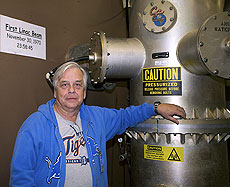Larry and the Linac: Larry Allen retires after 38 years
 |
| Engineering physicist Larry Allen in the Linac. Allen retired in December after nearly 39 years. |
In some ways, Larry Allen and the Linac have matured together. When Allen began working at Fermilab in 1972, the Linac was in its infant stages. Allen wasn't very old either – he'd just finished a program at DeVry.
"I saw an ad for Fermilab and thought that this would be a cool place to work," Allen said.
It was. But Allen hasn't just worked at the laboratory; he's helped to make the laboratory work.
During Allen's nearly 39-year career at Fermilab, he's spent about 30 of those years helping to tune, repair and replace parts in the Linac to keep it running. He recently retired in December.
"The group leader who preceded me said that the machine ran better when I was around," Allen said.
The Linac is a 500-foot-long linear accelerator that sends beams of negatively charged hydrogen ions to the next in a series of accelerators. It first sent beam to another accelerator in April of 1969.
"We had not gotten to 200 GeV when I started working here," Allen said.
Allen joined the laboratory in 1972 as an operator. He worked as an operations specialist from 1977 until 1990, when he became an engineering physicist. From the mid-90s until recently, he's worked as the Linac group leader. From the late 1970s until 2010, his focus was on the Linac.
For Allen, there is never a question of whether he can fix the Linac, said Bill Pellico, a colleague of Allen's for the past 25 years, there is just a question of how long that fix will take.
Pellico has worked on the Proton Source Department Booster since 1995, and Allen on the Linac side.
"When a failure occurs, Larry searches through the database in his head," Pellico said. "The systems fail in a similar way over the years and when a problem occurs, he's like a doctor – he looks at the symptoms and then solves the underlying problem."
When he began phased retirement in 2008, Allen handed over the accelerator reigns to Fernanda G. Garcia. However, he's still the person they call when the going gets really tough, or when things aren't going at all.
"There were instances where we were down for an extensive period of time chasing problems and trying to get machines back up and we'd have to call Larry for assistance at early hours of the day. He was always very professional and always willing to help," Garcia said. "He's a person you could count on. He knows every single bolt."
Most recently, Allen has spent his time mentoring those who will keep the Linac running in the future.
"Sometimes people push training others aside to get a machine up as quickly as possible," Pellico said. "But Larry would take a mentor role with trainees. He'd share and teach as much information as he could as they worked to get the machine back on."
Read more
- Rhianna Wisniewski
|